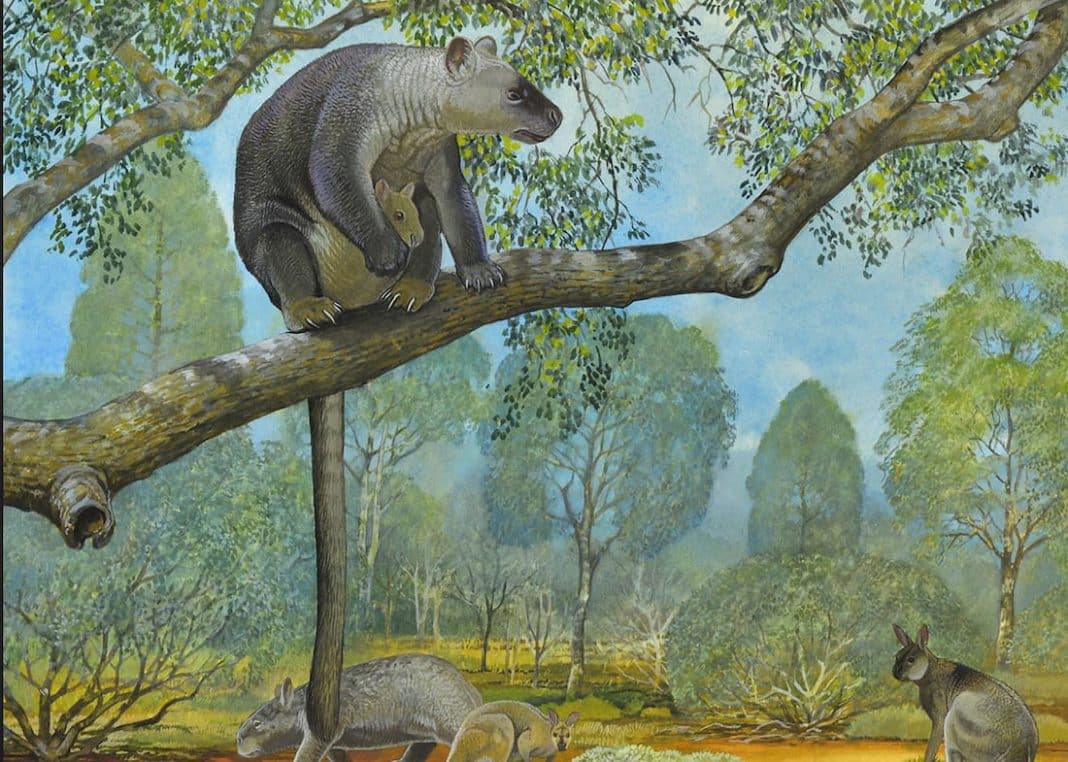A chance fossil find in a cave beneath the Nullarbor plain has helped scientists learn giant tree kangaroos were once widespread in Australia and adapted to drier conditions.
Tree kangaroos are now only found in the rainforests of far north Australia and New Guinea but in the distant past their giant relatives, some weighing up to 40 kilograms, were foraging in varied woodland habitats.
We know more about these now-extinct marsupials after two Australian scientists were able to identify their teeth and bones in museum collections, thanks to the Nullarbor finds by adventurous cavers about 20 years ago.
Professor Gavin Prideaux of Flinders University and Associate Professor Natalie Warburton of Murdoch University identified more than 100 teeth and bones belonging to seven species in the extinct tree kangaroo genus Bohra.
“It’s a bit like finding the picture on the front of a jigsaw box,” Prof Prideaux tells AAP.
He says the giant tree kangaroos in most regards were similar to modern tree kangaroos but there were distinct differences, particularly in the shape of their teeth and ankle bones.
“By finding these new skeletons of the giant ones in the Nullarbor, suddenly we were able to recognise the remains of giant ones in existing museum collections accumulated over the last 150 years or so,” Prof Prideaux says.
“We came to the realisation they were much more widespread and diverse than we’ve previously thought.”
The ages of the Bohra fossils range from 3.5 million to about 250,000 years old, although some might have survived until more recently.
Species of Bohra lived in central, southern and eastern Australia where habitats at the time were open woodland and savannah, including on the Nullarbor.
“The association between living tree kangaroos and rainforest is a recent phenomenon, and has come about only because of the extinction of giant tree kangaroos from non-forest habitats,” Prof Prideaux says.
Scientists believe the ancestors of modern kangaroos came down from the trees to the ground between 30 and 40 million years ago.
“Kangaroos have been hopping around on the ground for at least 30 million years but about five or so million years ago one particular group of kangaroos went back up into the trees and became what we now recognise as tree kangaroos,” Prof Prideaux says.
Later, as Australia dried out again, some species of Bohra adapted to more open habitats in yet another tree change.
To return to the trees, kangaroos needed to undo some adaptations.
The characteristic body plan of kangaroos that hop on two oversized hind legs became increasingly specialised over time.
“Kangaroos have long feet and legs, and their ankle bones lock together to limit sideways movement,” Prof Warburton says.
“This helps ensure that hopping across the ground is energetically efficient.
“However, flexibility and strength are advantages for climbing, so tree kangaroos evolved shorter, more flexible legs and feet, and more powerful arms and claws.”
The largest Bohra species might have weighed as much as 40kg, suggesting their climbing abilities differed.
“Modern tree kangaroos spend most of their time in the canopy,” Prof Warburton says.
“However, different species of Bohra probably differed in the proportion of time they spent living in trees and on the ground.
“This is similar to larger monkeys in Africa and Southeast Asia today.”
The paleontologists are looking forward to more fossil excavations in Australia and Papua New Guinea in the near future to shed more light on the long-gone giant tree roos.
“We don’t know what drove them to extinction but it’s amazing to think that not too long ago, possibly a few tens or a hundred thousand years ago, they were quite widespread across the continent,” Prof Prideaux says.
Climate change or hunting by humans could have caused the extinctions but there are not enough giant tree kangaroo remains from dated sites to determine if they were around when people arrived in Australia, he says.
“In time hopefully we’ll get a few more insights.”



